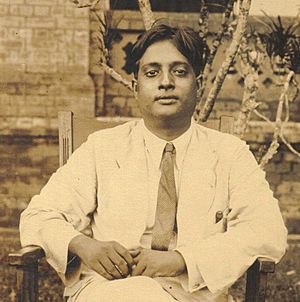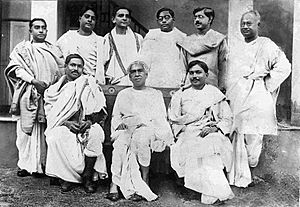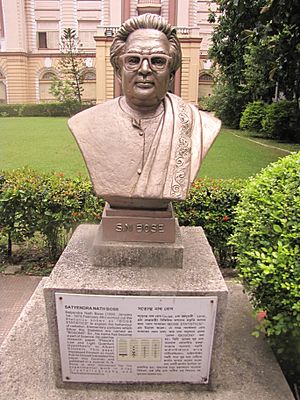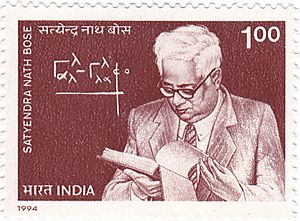Satyendra Nath Bose facts for kids
Quick facts for kids
Satyendra Nath Bose
|
|
|---|---|
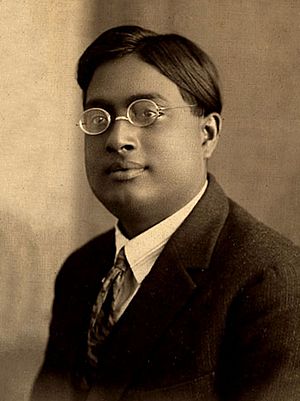
Bose in 1925
|
|
| Born |
Satyendra Nath Bose
1 January 1894 |
| Died | 4 February 1974 (aged 80) Calcutta, West Bengal, India
|
| Alma mater | University of Calcutta |
| Known for |
|
| Spouse(s) | Ushabati Bose (née Ghosh) |
| Awards | |
| Scientific career | |
| Fields | Physics, Quantum Mechanics, Mathematics |
| Institutions |
|
| Academic advisors |
|
| Doctoral students |
|
| Other notable students |
|
| Member of Parliament, Rajya Sabha | |
| In office 3 April 1952 – 2 April 1960 |
|
| Signature | |
 |
|
Satyendra Nath Bose (born January 1, 1894 – died February 4, 1974) was an amazing Indian mathematician and physicist. He was a true expert in theoretical physics. He is most famous for his work in the 1920s on quantum mechanics. This is a branch of physics that studies how tiny particles behave.
Bose helped create the ideas behind Bose-Einstein statistics and the Bose–Einstein condensate. These are very important concepts in understanding the universe. A special group of particles, called bosons, were even named after him by another famous scientist, Paul Dirac. Bose was also a Fellow of the Royal Society, which is a big honor for scientists. In 1954, the Indian government gave him the Padma Vibhushan, one of India's highest awards.
Bose was a polymath, meaning he was interested in many different subjects. These included physics, mathematics, chemistry, biology, philosophy, and even music. He also helped with many research projects in India.
Contents
Early Life and Education
Bose was born in Calcutta (now Kolkata). He was the oldest of seven children. He was the only son, with six younger sisters. His family's old home was in a village called Bara Jagulia.
Bose started school when he was five years old. He went to different schools as his family moved. He finished his entrance exam for college in 1909. He did very well, coming in fifth place. He then went to Presidency College in Calcutta. There, he was taught by famous scientists like Jagadish Chandra Bose and Prafulla Chandra Ray.
Satyendra Nath Bose earned his Bachelor of Science degree in mathematics in 1913. He was first in his class! Then, he joined the new Science College at the University of Calcutta. He again came first in his Master of Science (MSc) exam in 1915. His scores were so high that no one has beaten his record at the University of Calcutta since.
After his MSc, Bose became a research scholar at Science College in 1916. He began studying theory of relativity. This was a very exciting time for science. New ideas like quantum theory were just starting to appear.
In 1914, when he was 20, Bose married Ushabati Ghosh. She was 11 years old. They had nine children, but two sadly died when they were very young. When Bose passed away in 1974, he had his wife, two sons, and five daughters.
Bose was also a polyglot, meaning he spoke many languages. He knew Bengali, English, French, German, and Sanskrit. He also loved poetry and could play the esraj, an Indian instrument. He even helped run night schools for working people.
Research and Discoveries
From 1916 to 1921, Bose worked as a lecturer in the physics department at the Rajabazar Science College. In 1919, he and his friend Meghnad Saha wrote the first English book about Albert Einstein's special and general relativity theories. In 1921, Bose became a Reader (like a professor) in the Physics Department at the University of Dhaka. He helped set up new departments and laboratories there. He taught advanced courses like thermodynamics and electromagnetism.
In 1924, while at the University of Dhaka, Bose wrote a very important paper. He found a new way to explain Planck's law, which describes how light and heat are given off. He did this without using old physics ideas. Instead, he used a new way of counting how tiny, identical particles behave. This paper was a big step in creating the field of quantum statistics.
Bose sent his paper directly to Albert Einstein in Germany. Einstein quickly saw how important it was. He translated it into German himself and helped get it published in a famous science journal called Zeitschrift für Physik. Because of this, Bose got to work in Europe for two years. He worked with other famous scientists like Marie Curie and Einstein himself.
Bose–Einstein Statistics
Bose was giving a lecture at the University of Dhaka. He was talking about how the old theories couldn't explain some things about radiation. He realized that the usual way of counting particles, called the Maxwell–Boltzmann distribution, didn't work for very tiny particles. This is because of Heisenberg's uncertainty principle, which says you can't know everything about a tiny particle at once.
Bose found a new way to count these particles. He said that if two particles are exactly alike, you can't tell them apart. So, if you have two identical coins, getting "head-tail" is the same as "tail-head." This means there are fewer unique ways for them to be arranged.
Bose wrote down his ideas in a paper called "Planck's Law and the Hypothesis of Light Quanta." He sent it to Einstein with a letter saying:
Respected Sir, I have ventured to send you the accompanying article for your perusal and opinion. I am anxious to know what you think of it. You will see that I have tried to deduce the coefficient 8π ν2/c3 in Planck's Law independent of classical electrodynamics, only assuming that the ultimate elementary region in the phase-space has the content h3. I do not know sufficient German to translate the paper. If you think the paper worth publication I shall be grateful if you arrange for its publication in Zeitschrift für Physik. Though a complete stranger to you, I do not feel any hesitation in making such a request. Because we are all your pupils though profiting only by your teachings through your writings. I do not know whether you still remember that somebody from Calcutta asked your permission to translate your papers on Relativity in English. You acceded to the request. The book has since been published. I was the one who translated your paper on Generalised Relativity.
Einstein agreed with Bose's ideas. He translated the paper into German and made sure it was published. Bose's new way of counting particles is now called Bose-Einstein statistics. This idea was very important because it showed that tiny particles are truly "indistinguishable" from each other.
When Einstein met Bose, he asked if Bose knew he had invented a new kind of statistics. Bose honestly said no, he just did the calculations differently.
Bose–Einstein Condensate
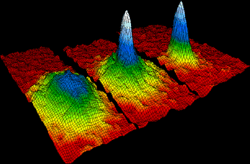
Einstein at first didn't fully realize how new Bose's idea was. But after using Bose's method in another paper, he predicted something amazing: the Bose–Einstein condensate. This is a special state of matter that happens when a group of bosons (particles named after Bose) are cooled to extremely low temperatures. At these temperatures, they all behave like one big "super-atom."
Bose had actually sent his paper to a British journal first, but it was rejected. We don't know why. But Einstein's work helped show the world how important Bose's ideas were. The Bose-Einstein condensate was finally created and proven to exist in experiments in 1995.
Work in Dhaka and Calcutta
After his time in Europe, Bose returned to Dhaka in 1926. Even though he didn't have a doctorate degree, Einstein recommended him. So, he became the Head of the Physics Department at Dhaka University. He continued to teach and guide students there.
Bose even designed his own equipment for an X-ray crystallography laboratory. He built labs and libraries to make the department a top place for research. He also published an equation of state for real gases with Meghnad Saha. He was also the Dean of the Faculty of Science at Dhaka University until 1945.
When India was divided in 1947, Bose moved back to Calcutta. He taught there until 1956. He believed that students should design their own equipment using local materials. After he retired, he became a professor emeritus. He then became the Vice-Chancellor of Visva-Bharati University. Later, he returned to the University of Calcutta to continue his research in nuclear physics.
Other Interests
Besides physics, Bose also did research in biotechnology and loved literature (both Bengali and English). He studied chemistry, geology, zoology, anthropology, and engineering. He was very proud of his Bengali heritage. He spent a lot of time promoting the Bengali language for teaching science and translating scientific papers into it.
Honours and Legacy
In 1937, the famous poet Rabindranath Tagore dedicated his only science book, Visva–Parichay, to Satyendra Nath Bose. The Indian Government honored Bose with the Padma Vibhushan award in 1954. In 1959, he was named the National Professor, which is the highest honor for a scholar in India. He held this position for 15 years. In 1986, the S.N. Bose National Centre for Basic Sciences was created in his honor in Calcutta.
Bose also advised the Council of Scientific and Industrial Research. He was the president of the Indian Physical Society and the National Institute of Science. He was also the general president of the Indian Science Congress. In 1958, he became a Fellow of the Royal Society. He was also chosen to be a member of the Rajya Sabha, which is part of India's Parliament.
Nobel Prize Nomination
S.N. Bose was nominated for the Nobel Prize in Physics several times. This was for his amazing work on Bose-Einstein statistics and the unified field theory. For example, in 1956, a professor named Kedareswar Banerjee wrote to the Nobel Committee. He said Bose's work on Bose statistics was very important for understanding fundamental particles and nuclear physics. An expert from the Nobel Committee, Oskar Klein, also thought Bose's work was worthy of a Nobel Prize.
Even though seven Nobel Prizes were given for research related to Bose's ideas (like bosons, Bose-Einstein statistics, and the Bose-Einstein condensate), Bose himself never received a Nobel Prize.
When someone asked Bose why he didn't get a Nobel Prize, he simply said, "I have got all the recognition I deserve." He probably meant that in science, having your name live on in important ideas is more valuable than any award.
One of the main science buildings at the University of Rajshahi has been named after him. On June 4, 2022, Google honored Bose with a special Google Doodle. This marked 98 years since he sent his important quantum ideas to Albert Einstein.
Works (selection)
- .
See also
 In Spanish: Satyendra Nath Bose para niños
In Spanish: Satyendra Nath Bose para niños


